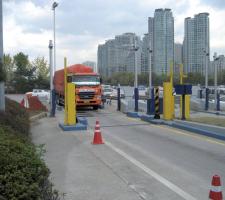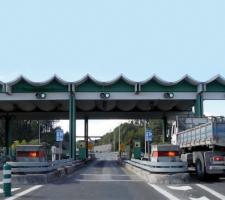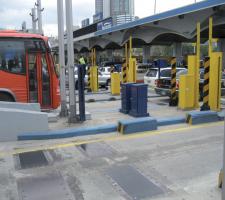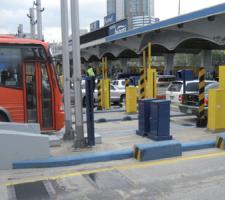
IRD, Inc's Terry Bergan discusses future applications of weigh in motion technology
The application in recent years of Weigh In Motion (WIM) at tollgates has been driven by recognition of the fact that there is economic value, which can be levied, attached to Heavy Goods Vehicles (HGVs) which haul laden (and are therefore heavy) rather than empty. As wear and damage to road surfaces increases exponentially with weight, the targeting of HGVs in particular makes sense from both the economic and maintenance perspectives andThe application of WIM at tolling facilities first started to occur around a decade ago but it is only in the last five years or so that the market, which is in many respects still in its infancy, really began to grow, says IRD's Terry Bergan.
"A number of years ago, there was no WIM at tollgates. Manual tolling facilities might have featured treadles and, at most for HGVs, some form of charging by vehicle class, number and spacing of axles, and possibly whether a vehicle was travelling loaded or empty. But there's a better return on tolling operations if HGVs are charged according to load. The idea first caught on in South Korea and has since gained traction in numerous Asian countries, such as China, India and Pakistan. We're also seeing deployments in Brazil. It's still a new concept in many countries and regions, however, and many have still to adopt it."
Emerging symbioses
Bergan sees a closer and more complex relationship developing between WIM and machine vision in coming years. The latter is an increasingly fashionable and broadening term which encompasses such long-established technologies as automatic number plate recognition as well as other and more recent image-based detection and monitoring solutions.
"There's a tolling application here, in that truck owners and operators don't want to have to deal with 'Christmas trees' of transponders, and an HGV identification one. There are also cooperative vehicle applications, where enforcement officers want to interrogate vehicles on the move.
"The nice thing about machine vision is that no-one has to carry anything; everything is external to the vehicle. That significantly increases the application of enforcement schemes for DOTs.
As soon as you move into vision-based technologies, the truck owner doesn't have to do anything. All a scheme has to do is tie a vehicle to a database. Some people think that electronic tagging has had its day but I think, again, it depends on application. If you want to use machine vision, you have to have a means of tying it to a viable, accurate database. Many developing countries don't have one of those. As a result, it's developed countries which can benefit most from machine vision at present.
"I think that machine vision and onboard sensors will co-exist for quite some time as different business models vie for market share and play themselves out in a manner which reflects the tag-versus-video situation we have now. For instance, in tolling you might offer schemes' users lower fees if they pay using automatic vehicle identification."
Machine vision will also allow you to go out and enforce at remote traffic data collection stations where WIM exists.
"It's common on many roads that at certain times of the day there is a preponderance of overweight vehicles. A traffic data site with WIM can gather this information, while machine vision and wireless technologies will allow you to go out and enforce. As with transponders and machine vision, there will also be a co-existence with WIM in coming years.
"For IRD, at present, the biggest markets for such solutions are the US and Canada. These are rapidly growing but still relatively small markets, however."
Addressing obstacles to adoption
The application of WIM allows tolling operations to disallow grossly overweight vehicles, or else disproportionately charge according to the exponential roadway damage that overloading causes. A perceived non-operational obstacle to adoption is that many existing concessions' terms of operation are strictly governed by agreements with financiers. Bergan says that geography plays a part."WIM's adoption can do nothing but increase the revenue model and decrease maintenance costs. It can work with open or closed, manual or open-road tolling systems.
"However in some countries, and the US is among them, there are institutional implications associated with its introduction because of the adherence to certain vehicle weight and size criteria. In developing countries, that's not the case and such barriers to its introduction simply don't exist or can be readily got over.
"There's an education process which still has to take place. Some countries still see WIM as a revenue source but its real purpose is to help manage maintenance costs. Adding WIM adds another dimension to traffic data analysis and forecasting for highway needs and design; design people need accurate classification data such as numbers of axles and vehicles' gross weights.
"Tolling might have different criteria but the technology can overcome that. Loops may have limitations versus treadles, which in turn have limitations versus WIM, but only in some applications; it may be that in some settings overall vehicle dimensions are the most important consideration."
Classification criteria
Vehicle classification criteria can vary widely and their origins can seem somewhat arcane. A discussion point is whether there needs to be a more unified system. Again, Bergan says that progress depends on location."Whether unification is seen to be gaining traction depends on who you talk to. In Europe, I'd say there's been progress. In the US it varies coast to coast, just as road design does. In some areas of Canada, for example, flexible pavement is most common; you won't see much rigid Portland cement pavement . Go to some countries and if you suggest more than three classification criteria you'll be looked at as if you're crazy, whereas elsewhere you're left scratching your head as to where the criteria were ever dreamed up.
"The bottom line is that the technology can always be provided to support a design need if customers are prepared to pay. On toll roads, the main aim might be to maximise revenue but as schemes mature and more engineers get involved in their running there's a greater interest in improving data."
Bring-back concepts
At the outset, this idea is becoming more popular in some markets. India, for example, is making significant investments in new road infrastructure and seeing corresponding growth in HGV traffic. Recognising the risk, the country's transport minister has given his backing to the application of WIM on tolled facilities.Bergan says that there are several areas in which developed countries can learn from emerging ones.
"Leading-edge technologies tend to be more expensive and in developing markets their appearance depends on the ability to attract capital. Vietnam, for instance, would benefit significantly from the best that technology has to offer but doesn't have the cash for it. In Africa, if you're going to sell the traffic data concept you need to keep it simple and it needs to be able to run forever on batteries: we're back to the situation of simple traffic counters and limited operations outside towns and cities.
"But places like China and India don't have that problem of attracting investment and we're seeing some significant systems going in. India, for example, doesn't yet have open-road tolling because currently there's not the discipline among road users for it to be a success. The traffic monitoring technology which is going in is cutting edge, though: electronic toll collection to an agreed national standard; vehicle dimensional measurement; and non-invasive sensors. There's a lot that developed countries can learn from such installations in terms of bridge protection, for example."
Using WIM to complete the pictureWe can expect that since weight-based tolling is based on a cost to cause principle it will push back into traditional markets from developing countries, says
"Overloading can destroy a well-constructed road in just a couple of years and there's a big interest in addressing this issue at the moment, not only from the public sector but also from toll road concessionaires." For tolling by weight Kistler offers a range of solutions all based on its well-established piezo quartz sensors. There is, says Cornu, no need for a new type of sensor - the main developments for such applications are in the data processing area.
Looking forward, the near-term trend is towards automatic measurement of vehicle weight using WIM systems
Addressing safety and emissions
Even in developing countries, there is a recognition of the part that WIM can play in reducing emissions, says Bergan.
"It's very much little steps, but in countries like India the little put-puts which the majority of people use to get around are all LPG now. Increasingly, across the board, vehicles are more efficient. There are still older trucks lumbering around but in time they'll disappear.
"WIM is important because it reduces the inefficiencies of stop-start traffic as well as the associated fuel consumption and carbon emissions. In many such countries, it remains true that most people are more concerned with merely surviving from day to day. They can't afford themselves the luxury of thinking about the environment, so it would be wrong to say that there's an overall recognition of the issue among such countries' populations. But there's certainly a political aspiration to get to grips with things."There are big pressures to cut time and personnel costs and that's pushing the wider adoption of electronic toll collection and greater automation in WIM. A related development, in the sense that it's also a form of 'tolling', is the use of WIM at loading stations. At railheads, ports and harbours, it used to be that vehicle weights were taken from shipping declarations. This reliance on paperwork can be very inaccurate and is open to abuse. However, static weighing is a very slow process.
"Kistler has introduced a system very similar to that for tolling applications which can be used to monitor the weight of all vehicles entering and leaving a facility. Weight information is related to the vehicles' license plates in an automated process which is less susceptible to corruption. This is still very much a niche market but it's growing, especially in Europe.
"Again, for this application the technology is essentially mature although there is space in the future to automatically certify vehicles in terms of weight. We need common strategies in place from country to country to allow that to happen, though, and that's where the greater challenges are; even in one country alone you're going to have several agencies involved - the public sector, law enforcement and the private-sector customer and hauliers, for instance - and each will have its own view on what's of greatest importance in terms of weight monitoring or enforcement."















